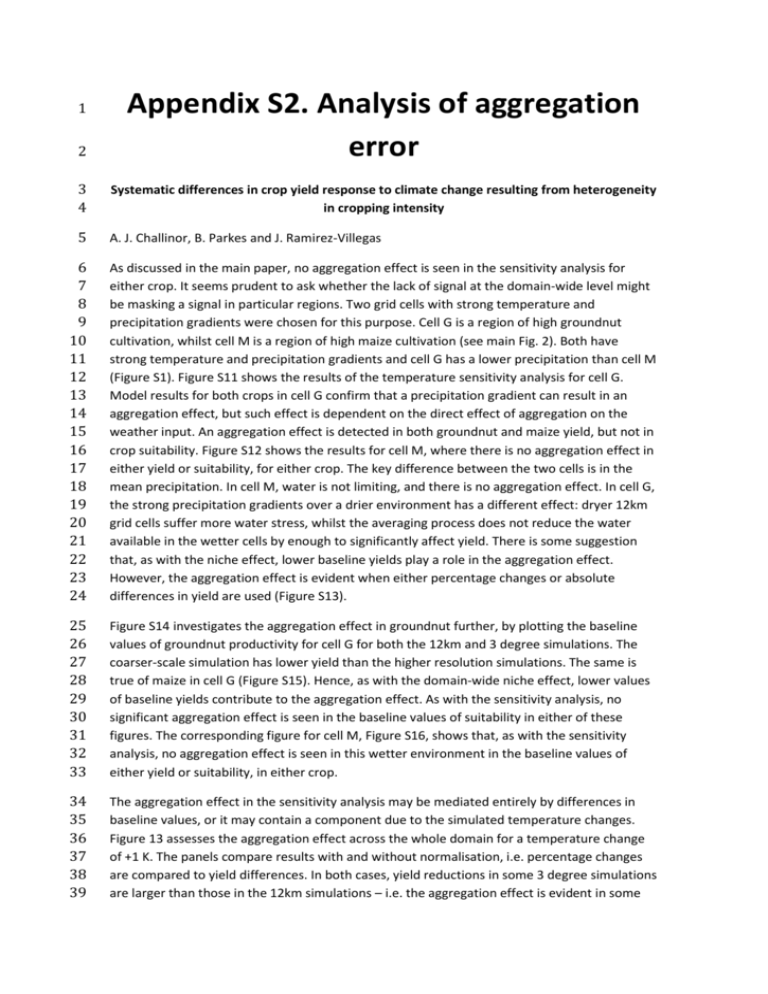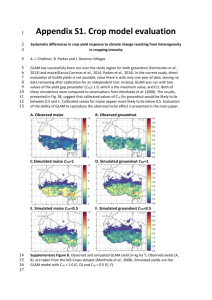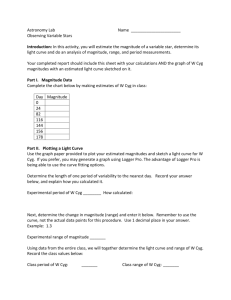gcb12808-sup-0002-AppendixS2
advertisement

2 Appendix S2. Analysis of aggregation error 3 4 Systematic differences in crop yield response to climate change resulting from heterogeneity in cropping intensity 5 A. J. Challinor, B. Parkes and J. Ramirez-Villegas 1 6 7 8 9 10 11 12 13 14 15 16 17 18 19 20 21 22 23 24 As discussed in the main paper, no aggregation effect is seen in the sensitivity analysis for either crop. It seems prudent to ask whether the lack of signal at the domain-wide level might be masking a signal in particular regions. Two grid cells with strong temperature and precipitation gradients were chosen for this purpose. Cell G is a region of high groundnut cultivation, whilst cell M is a region of high maize cultivation (see main Fig. 2). Both have strong temperature and precipitation gradients and cell G has a lower precipitation than cell M (Figure S1). Figure S11 shows the results of the temperature sensitivity analysis for cell G. Model results for both crops in cell G confirm that a precipitation gradient can result in an aggregation effect, but such effect is dependent on the direct effect of aggregation on the weather input. An aggregation effect is detected in both groundnut and maize yield, but not in crop suitability. Figure S12 shows the results for cell M, where there is no aggregation effect in either yield or suitability, for either crop. The key difference between the two cells is in the mean precipitation. In cell M, water is not limiting, and there is no aggregation effect. In cell G, the strong precipitation gradients over a drier environment has a different effect: dryer 12km grid cells suffer more water stress, whilst the averaging process does not reduce the water available in the wetter cells by enough to significantly affect yield. There is some suggestion that, as with the niche effect, lower baseline yields play a role in the aggregation effect. However, the aggregation effect is evident when either percentage changes or absolute differences in yield are used (Figure S13). 25 26 27 28 29 30 31 32 33 Figure S14 investigates the aggregation effect in groundnut further, by plotting the baseline values of groundnut productivity for cell G for both the 12km and 3 degree simulations. The coarser-scale simulation has lower yield than the higher resolution simulations. The same is true of maize in cell G (Figure S15). Hence, as with the domain-wide niche effect, lower values of baseline yields contribute to the aggregation effect. As with the sensitivity analysis, no significant aggregation effect is seen in the baseline values of suitability in either of these figures. The corresponding figure for cell M, Figure S16, shows that, as with the sensitivity analysis, no aggregation effect is seen in this wetter environment in the baseline values of either yield or suitability, in either crop. 34 35 36 37 38 39 The aggregation effect in the sensitivity analysis may be mediated entirely by differences in baseline values, or it may contain a component due to the simulated temperature changes. Figure 13 assesses the aggregation effect across the whole domain for a temperature change of +1 K. The panels compare results with and without normalisation, i.e. percentage changes are compared to yield differences. In both cases, yield reductions in some 3 degree simulations are larger than those in the 12km simulations – i.e. the aggregation effect is evident in some 40 41 grid cells when either metric is used. Hence, the aggregation effect is not mediated through baseline differences alone. 42 43 44 45 46 A. GLAM maize CYG=1 B. GLAM maize CYG=0.5 C. GLAM groundnut CYG=1 D. GLAM groundnut CYG=0.5 E. EcoCrop maize F. EcoCrop groundnut Figure S11. Scatter plots of crop yield and suitability response to temperature change for both crops in grid cell G (see main Fig. 2). GLAM maize yield simulations (A, B) have two values of CYG. Corresponding groundnut simulations are also shown (C, D). EcoCrop maize suitability simulations for both crops are shown in panels E and F. 47 48 49 50 51 52 53 A. GLAM maize CYG=1 B. GLAM maize CYG=0.5 C. GLAM groundnut CYG=1 D. GLAM groundnut CYG=0.5 E. EcoCrop maize F. EcoCrop groundnut Figure S12. Scatter plots of crop yield and suitability response to temperature change for both crops in grid cell M (see main Fig. 2). GLAM maize yield simulations with CYG = 1 (A) and CYG = 0.5 (B); corresponding GLAM groundnut simulations (C, D); and EcoCrop maize (E) and groundnut (F) suitability simulations. 54 55 56 57 58 59 A. 3 degree differences B. 12km differences C. 3 degree percent D. 12km percent Figure S13. Comparison between differences (in kg ha-1) and relative changes (%) in yield between the control and the +1 K simulation. Maize on the 3 degree (A) and 12 km grid aggregated to the 3 degree grid (B); and corresponding percentage changes (C, D). 60 A. GLAM B. GLAM C. EcoCrop D. EcoCrop 61 62 63 64 65 66 67 68 69 70 71 72 73 74 75 Figure S14. Effect of aggregating 12 km meteorological data to 3x3 degree for groundnut in cell G. Line shows: normalised GLAM yield (CYG = 1) against temperature (A) and precipitation (B); EcoCrop suitability against temperature (C) and precipitation (D). Mean temperature and precipitation during the crop growth period in the 12km simulations are shown as bars. These are centred on mean values of temperature or precipitation from the 12km simulations. Black stars show the 3 degree value of productivity or suitability and red stars show the average values from the 12km simulations. Thus the red stars are by definition at x=0, whilst the x value of the black stars reflects differences in planting and harvest date, which affect the averaging period. The Productivity index, defined in order to normalise the results from GLAM, is the ratio between the mean yield for a given 0.5 degree range and the maximum yield found in a single 12km cell. 76 77 78 79 80 81 82 A. GLAM B. GLAM C. EcoCrop D. EcoCrop Figure S15. Effect of aggregating 12 km meteorological data to 3x3 degree for maize in cell G. Normalised GLAM yield (CYG = 1) against temperature (A) and precipitation (B); EcoCrop suitability against temperature (C) precipitation (D). This construction of this figure is exactly as Supplementary Fig. 16. The Productivity index, defined in order to normalise the results from GLAM, is the ratio between the mean yield for a given 0.5 degree range and the maximum yield found in a single 12km cell. 83 84 85 86 87 88 89 90 A. GLAM CYG=1 B. GLAM CYG=0.5 C. GLAM CYG=0.5 D. GLAM CYG=0.5 E. EcoCrop F. Ecocrop Figure S16. Line plots showing the effect of aggregating 12 km meteorological data to 3x3 degree for the maize in focus area (marked as ‘M’ in Fig. 1, main text). Normalised GLAM yield with CYG = 1 against temperature (A) and precipitation (B); normalised GLAM yield with CYG = 0.5 against temperature (C) and precipitation (D); EcoCrop suitability against temperature (E) and precipitation (F). The Productivity index, defined in order to normalise the results from GLAM, is the ratio between the mean yield for a given 0.5 degree range and the maximum yield found in a single 12km cell.








